#Camelus dromedarius
Explore tagged Tumblr posts
Text

Dromedary camel Camelus dromedarius
Observed by rich_fuller, public domain
#Camelus dromedarius#dromedary camel#Camelidae#camel#Oceania#Australia#Northern Territory#introduced
167 notes
·
View notes
Text
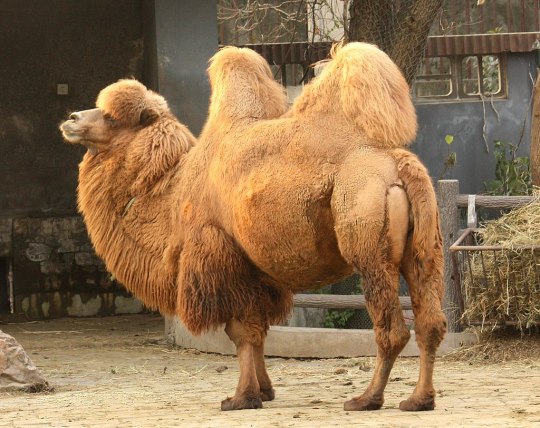


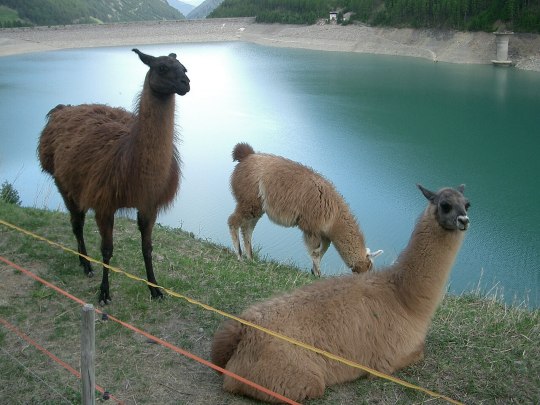
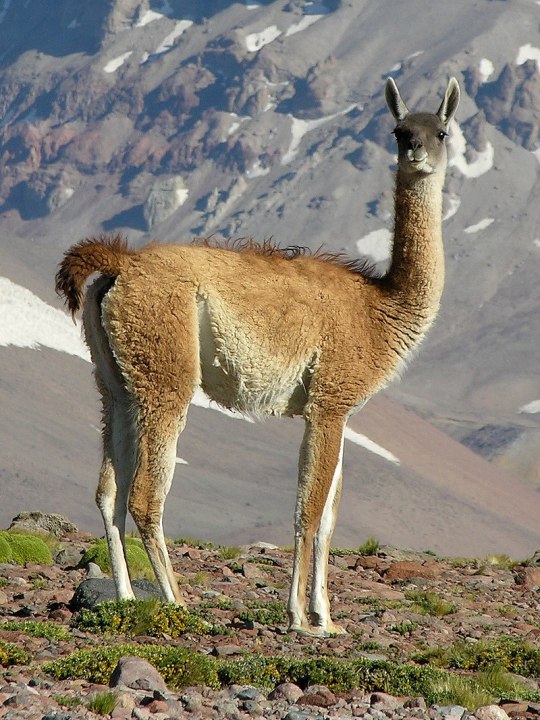


#poll#random poll#fun polls#poll time#my polls#tumblr polls#random polls#polls#fandom polls#tumblr poll#polls on tumblr#polls are fun#polls polls polls#camel#animal#llama#alpacas#alpaca#Camelinae#Bactrian camel#Camelus bactrianus#Wild Bactrian camel#Camelus ferus#Dromedary camel#Camelus dromedarius#Llama#Lama glama#Guanaco#Lama guanicoe#Alpaca
22 notes
·
View notes
Text
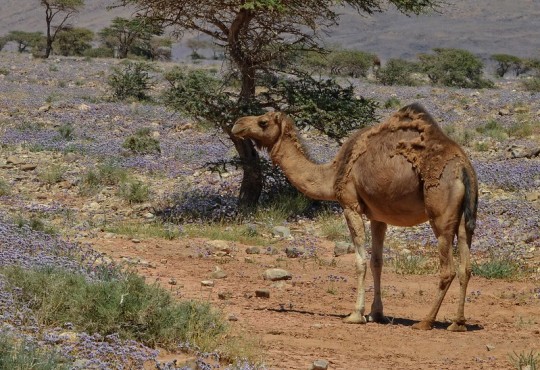
A dromedary (Camelus dromedarius) amongst the brush in Morocco
by Alexandre Roux
#dromedary#camels#camelids#camelus dromedarius#camelus#camelidae#artiodactyla#mammalia#chordata#wildlife: morocco#wildlife: africa
70 notes
·
View notes
Text

Behold, a creetchur
Meet Stecoteuthops stictis, the "spotted standing squid-face". It's one of the most important creatures for my in-the-works Spec project. Basically the premise is that many years in the future, humanity colonized a distant desert planet (Spero) with the intent on terraforming it to become a new colony. However, something went horribly wrong, and humanity was wiped out, leaving behind only the livestock and crops they brought with them. This transitional form lives about 60 million years post-cataclysm and is a descendant of the Dromedary Camel (Camelus dromedarius).
Stecoteuthops is part of a particularly successful radiation of camels which possess subcutaneous osteoderms for defense against predators. In this genus, the osteoderms along the midline of the back have formed tall struts which support a decorative sail of skin. This sail is used for display and also to break up its outline in its woodland home, helping the animal to hide from predators; males have much taller sails than females.
This animal is most similar in form and function to the ancient stem-camel Anoplotherium, possessing a muscular, elongated tail which is used to support the body while browsing. Their pincer-like forelimbs can be used to grasp branches and pull them down to access fresh fruits and tender new leaves. They are obligate herbivores, and fruit forms over 70% of their diet - their dextrous, almost tentacular lips are used to grasp and manipulate ripe fruit, and are lined with cornified papillae to ensure a firm grip. Their fur is greenish-blue, the result of a novel pigment derived from Biliverdin which evolved near the very base of the camel radiation, shortly after colonization.
Stecoteuthops is important to this world because it represents a transitional form between large, ground-dwelling camels and smaller, arboreal forms. Although Stecoteuthops itself does not climb, its grasping feet, small size, and muscular tail are all preadaptations for arboreality, and its descendants will clamber about the canopy in search of fresh fruit. It is this lifestyle which will enable the camels to survive the coming mass extinction, priming them to diversify into one of the dominant clades on the planet Spero.

#speculative biology#spec bio#speculative evolution#spec evo#speculative fiction#creature design#creature#seed world#Vicis Aeternum#Spero
151 notes
·
View notes
Text
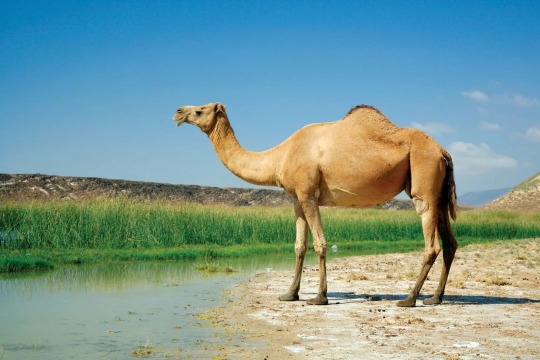
Dromedary camel (Camelus dromedarius)
This species of camel is a textbook case of evolution for dry desert environments. Despite this, wild dromedary camels went extinct more than a thousand years ago; the only living individuals are domesticated. Wild camels once ranged in desert habitats from North Africa to Western Asia, eating dry, spiny plants and adapted to go many days without water or food. They were domesticated thousands of years ago, and since then have served as important pack animals and livestock, especially in the African and Asian regions where they used to live wild. They have also played a role in the recent history of Australia, once used by non-indigenous peoples to cross the great central deserts, and now found as an invasive species across the northwest.
#markhors-menagerie#animal facts#animals#biology#fun facts#ungulates#even toed ungulates#camels#dromedary camel#camelidae
23 notes
·
View notes
Text

INKTOBER 2023 Day 13 - Camel (Camelus dromedarius)
Patreon / Ko-fi / Society6 / Redbubble / Commissions / Colouring book
21 notes
·
View notes
Text
All animal species (and a couple algae) that have kept the same scientific name since Linnaeus
The first work of taxonomy that is considered as having any scientific authority for animal species was the 10th edition of Linnaeus' Systema Naturae, published in 1758. (Also a book on spiders called Aranei Suecici, published one year before.) That's the foundational text of the binominal system of nomenclature of species still in use today. Since then most of Linnaeus' original species (4379 species, of which 185 mammals, 554 birds, 217 "amphibians" (including reptiles and cartilaginous fish), 379 fishes, 2104 "insects" (including various arthropods, of which 664 are beetles and 543 are moths & butterflies crammed into only 3 genera), and 940 "worms" (including basically all other invertebrates, and even some protists and algae)) have been dismembered, renamed, or at least moved to different genera (e.g. the house sparrow went from Fringilla domestica to Passer domesticus).
Here is a list of all of Linnaeus' original species from 1758 that still retain their original name. I believe they are 484 in total.
"Mammalia"
(Primates)
Homo sapiens (human)
Lemur catta (ring-tailed lemur)
Vespertilio murinus (rearmouse bat)
(Bruta)
Elephas maximus (Asian elephant)
Trichechus manatus (West Indian manatee)
Bradypus tridactylus (three-toed sloth)
Myrmecophaga tridactyla (giant anteater)
Manis pentadactylus (Chinese pangolin)
(Ferae)
Phoca vitulina (harbor seal)
Canis familiaris (dog)
Canis lupus (grey wolf)
Felis catus (house cat)
Viverra zibetha (Indian civet)
Mustela erminea (stoat)
Mustela furo (ferret)
Mustela lutreola (European mink)
Mustela putorius (wild ferret)
Ursus arctos (brown bear)
(Bestiae)
Sus scrofa (wild boar/pig)
Dasypus septemcinctus (seven-banded armadillo)
Dasypus novemcinctus (nine-banded armadillo)
Erinaceus europaeus (European hedgehog)
Talpa europaea (European mole)
Sorex araneus (common shrew)
Didelphis marsupialis (common opossum)
(Glires)
Rhinoceros unicornis (Indian rhinoceros)
Hystrix brachyura (Malayan porcupine)
Hystrix cristata (crested porcupine)
Lepus timidus (common hare)
Castor fiber (European beaver)
Mus musculus (house mouse)
Sciurus vulgaris (red squirrel)
(Pecora)
Camelus dromedarius (dromedary camel)
Camelus bactrianus (Asian camel)
Moschus moschiferus (musk deer)
Cervus elaphus (red deer)
Capra hircus (goat)
Capra ibex (Alpine ibex)
Ovis aries (sheep)
Bos taurus (cow)
Bos indicus (zebu)
(Belluae)
Equus caballus (horse)
Equus asinus (donkey)
Equus zebra (mountain zebra)
Hippopotamus amphibius (hippopotamus)
(Cete)
Monodon monoceros (narwhal)
Balaena mysticetus (bowhead whale)
Physeter macrocephalus (sperm whale)
Delphinus delphis (common dolphin)
"Aves"
(Accipitres)
Vultur gryphus (Andean condor)
Falco tinnunculus (common kenstrel)
Falco sparverius (sparrowhawk)
Falco columbarius (pigeonhawk)
Falco subbuteo (Eurasian hobby)
Falco rusticolus (gyrfalcon)
Strix aluco (tawny owl)
Lanius excubitor (great grey shrike)
Lanius collurio (red-backed shrike)
Lanius schach (long-tailed shrike)
(Picae)
Psittacus erithacus (grey parrot)
Ramphastos tucanus (white-throated toucan)
Buceros bicornis (great hornbill)
Buceros rhinoceros (rhinoceros hornbill)
Crotophaga ani (smooth-billed ani)
Corvus corax (raven)
Corvus corone (carrion crow)
Corvus frugilegus (rook)
Corvus cornix (hooded crow)
Coracias oriolus (golden oriole)
Coracias garrulus (European roller)
Gracula religiosa (hill myna)
Paradisaea apoda (greater bird-of-paradise)
Cuculus canorus (common cuckoo)
Jynx torquilla (wryneck)
Picus viridis (green woodpecker)
Sitta europaea (Eurasian nuthatch)
Merops apiaster (European bee-eater)
Merops viridis (blue-throated bee-eater)
Upupa epops (Eurasian hoopoe)
Certhia familiaris (Eurasian treecreeper)
Trochilus polytmus (red-billed streamertail hummingbird)
(Anseres)
Anas platyrhynchos (mallard duck)
Anas crecca (teal duck)
Mergus merganser (common merganser)
Mergus serrator (red-breasted merganser)
Alca torda (razorbill auk)
Procellaria aequinoctialis (white-chinned petrel)
Diomedea exulans (wandering albatross)
Pelecanus onocrotalus (great white pelican)
Phaeton aethereus (red-billed tropicbird)
Larus canus (common gull)
Larus marinus (great black-backed gull)
Larus fuscus (lesser black-backed gull)
Sterna hirundo (common tern)
Rhynchops niger (black skimmer)
(Grallae)
Phoenicopterus ruber (American flamingo)
Platalea leucorodia (Eurasian spoonbill)
Platalea ajaia (roseate spoonbill)
Mycteria americana (wood stork)
Ardea cinerea (grey heron)
Ardea herodias (blue heron)
Ardea alba (great egret)
Scolopax rusticola (Eurasian woodcock)
Charadrius hiaticula (ringed plover)
Charadrius alexandrinus (Kentish plover)
Charadrius vociferus (killdeer plover)
Charadrius morinellus (Eurasian dotterel)
Recurvirostra avosetta (pied avocet)
Haematopus ostralegus (Eurasian oystercatcher)
Fulica atra (Eurasian coot)
Rallus aquaticus (water rail)
Psophia crepitans (grey-winged trumpeter)
Otis tarda (great bustard)
Struthio camelus (ostrich)
(Gallinae)
Pavo cristatus (Indian peafowl)
Meleagris gallopavo (wild turkey)
Crax rubra (great curassow)
Phasianus colchicus (common pheasant)
Tetrao urogallus (western capercaillie)
(Passeres)
Columba oenas (stock dove)
Columba palumbus (wood pigeon)
Alauda arvensis (Eurasian skylark)
Sturnus vulgaris (European starling)
Turdus viscivorus (mistle thrush)
Turdus pilaris (fieldfare thrush)
Turdus iliacus (redwing thrush)
Turdus plumbeus (red-legged thrush)
Turdus torquatus (ring ouzel)
Turdus merula (blackbird)
Loxia curvirostra (crossbill)
Emberiza hortulana (ortolan bunting)
Emberiza citrinella (yellowhammer)
Emberiza calandra (corn bunting)
Fringilla coelebs (common chaffinch)
Motacilla alba (white wagtail)
Motacilla lava (yellow wagtail)
Parus major (great tit)
Hirundo rustica (barn swallow)
Caprimulgus europaeus (European nightjar)
"Amphibia"
(Reptiles)
Testudo graeca (Greek tortoise)
Draco volans (flying dragon)
Lacerta agilis (sand lizard)
Rana temporaria (common frog)
(Serpentes)
Crotalus horridus (timber rattlesnake)
Crotalus durissus (tropical rattlesnake)
Boa constrictor (common boa)
Coluber constrictor (eastern racer)
Anguis fragilis (slowworm)
Amphisbaena alba (red worm lizard)
Caecilia tentaculata (white-bellied caecilian)
(Nantes)
Petromyzon marinus (sea lamprey)
Raja clavata (thornback ray)
Raja miraletus (brown ray)
Squalus acanthias (spiny dogfish)
Chimaera monstrosa (rabbitfish)
Lophius piscatorius (anglerfish)
Acipenser sturio (sea sturgeon)
Acipenser ruthenus (sterlet sturgeon)
"Pisces"
(Apodes)
Muraena helena (Mediterranean moray)
Gymnotus carapo (banded knifefish)
Trichiurus lepturus (cutlassfish)
Anarhichas lupus (Atlantic wolffish)
Ammodytes tobianus (lesser sandeel)
Xiphias gladius (swordfish)
Stromateus fiatola (blue butterfish)
(Jugulares)
Callionymus lyra (common dragonet)
Uranoscopus scaber (stargazer)
Trachinus draco (greater weever)
Gadus morhua (Atlantic cod)
Blennius ocellaris (butterfly blenny)
Ophidion barbatum (snake cusk-eel)
(Thoracici)
Cyclopterus lumpus (lumpsucker)
Echeneis naucrates (sharksucker)
Coryphaena equiselis (pompano)
Coryphaena hippurus (dorado)
Gobius niger (black goby)
Govius paganellus (rock goby)
Cottus gobio (European bullhead)
Scorpaena porcus (black scorpionfish)
Scorpaena scrofa (red scorpionfish)
Zeus faber (John Dory)
Pleuronectes platessa (European plaice)
Chaetodon striatus (banded butterflyfish)
Chaetodon capistratus (foureye butterflyfish)
Sparus aurata (gilt-head bream)
Labrus merula (brown wrasse)
Labrus mixtus (cuckoo wrasse)
Labrus viridis (green wrasse)
Sciaena umbra (brown meagre)
Perca fluviatilis (European perch)
Gasterosteus aculeatus (three-spined stickleback)
Scomber scombrus (Atlanti mackerel)
Mullus barbatus (red mullet)
Mullus surmuletus (surmullet)
Trigla lyra (piper gurnard)
(Abdominales)
Cobitis taenia (spined loach)
Silurus asotus (Amur catfish)
Silurus glanis (Wels catfish)
Loricaria cataphracta (suckermouth catfish)
Salmo carpio (Garda trout)
Salmo trutta (brown trout)
Salmo salar (Atlantic salmon)
Fistularia tabacaria (bluespotted cornetfish)
Esox lucius (northern pike)
Argentina sphyraena (European argentine)
Atherina hepsetus (Mediterranean sand smelt)
Mugil cephalus (flathead mullet)
Exocoetus volitans (tropical flying fish)
Polynemus paradiseus (Paradise threadfin)
Clupea harengus (Atlantic herring)
Cyprinus carpio (common carp)
(Branchiostegi)
Mormyrus caschive (bottlenose elephantfish)
Balistes vetula (queen triggerfish)
Ostracion cornutus (longhorn cowfish)
Ostracion cubicus (yellow boxfish)
Tetraodon lineatus (Fahaka pufferfish)
Diodon hystrix (spot-fin porcupinefish)
Diodon holocanthus (long-spine porcupinefish)
Centriscus scutatus (grooved shrimpfish)
Syngnathus acus (common pipefish)
Syngnathus pelagicus (pelagic pipefish)
Syngnathus typhle (broad-nosed pipefish)
Pegasus volitans (longtail seamoth)
"Insecta"
(Coleoptera)
Scarabaeus sacer (sacred scarab)
Dermestes lardarius (larder beetle)
Dermestes murinus (larder beetle)
Hister unicolor (clown beetle)
Hister quadrimaculatus (clown beetle)
Silpha obscura (carrion beetle)
Cassida viridis (tortoise beetle)
Cassida nebulosa (tortoise beetle)
Cassida nobilis (tortoise beetle)
Coccinella trifasciata (ladybug)
Coccinella hieroglyphica (ladybug) [Coccinella 5-punctata, 7-punctata, 11-punctata, and 24-punctata survive as quinquepunctata, septempunctata, undecimpunctata, and vigintiquatorpunctata]
Chrysomela populi (leaf beetle)
Chrysomela lapponica (leaf beetle)
Chrysomela collaris (leaf beetle)
Chrysomela erythrocephala (leaf beetle)
Curculio nucum (nut weevil)
Attelabus surinamensis (leaf-rolling weevil)
Cerambyx cerdo (capricorn beetle)
Leptura quadrifasciata (longhorn beetle)
Cantharis fusca (soldier beetle)
Cantharis livida (soldier beetle)
Cantharis oscura (soldier beetle)
Cantharis rufa (soldier beetle)
Cantharis lateralis (soldier beetle)
Elater ferrugineus (rusty click beetle)
Cicindela campestris (green tiger beetle)
Cicindela sylvatica (wood tiger beetle)
Buprestis rustica (jewel beetle) [Buprestis 8-guttata survives as octoguttata]
Dytiscus latissimus (diving beetle)
Carabus coriaceus (ground beetle)
Carabus granulatus (ground beetle)
Carabus nitens (ground beetle)
Carabus hortensis (ground beetle)
Carabus violaceus (ground beetle)
Tenebrio molitor (mealworm)
Meloe algiricus (blister beetle)
Meloe proscarabaeus (blister beetle)
Meloe spec (blister beetle)
Mordela aculeata (tumbling glower beetle)
Necydalis major (longhorn beetle)
Staphylinus erythropterus (rove beetle)
Forficula auricularia (common earwig)
Blatta orientalis (Oriental cockroach)
Gryllus campestris (field cricket)
(Hemiptera)
Cicada orni (cicada)
Notonecta glauca (backswimmer)
Nepa cinerea (water scorpion)
Cimex lectularius (bedbug)
Aphis rumici (black aphid)
Aphis craccae (vetch aphid)
Coccus hesperidum (brown scale insect)
Thrips physapus (thrips)
Thrips minutissimum (thrips)
Thrips juniperinus (thrips)
(Lepidoptera)
Papilio paris (Paris peacock butterfly)
Papilio helenus (red Helen butterfly)
Papilio troilus (spicebush swallowtail butterfly)
Papilio deiphobus (Deiphobus swallowtail butterfly)
Papilio polytes (common Mormon butterfly)
Papilio glaucus (eastern tiger swallowtail butterfly)
Papilio memnon (great Mormon butterfly)
Papilio ulysses (Ulysses butterfly)
Papilio machaon (Old World swallowtail butterfly)
Papilio demoleus (lime swallowtail butterfly)
Papilio nireus (blue-banded swallowtail butterfly)
Papilio clytia (common mime butterfly)
Sphinx ligustri (privet hawk-moth)
Sphinx pinastri (pine hawk-moth) [genus Phalaena was suppressed, but seven subgenera created by Linnaeus are now valid as genera]
(Neuroptera)
Libellula depressa (chaser dragonfly)
Libellula quadrimaculata (four-spotted skimmer dragonfly)
Ephemera vulgata (mayfly)
Phryganea grandis (caddisfly)
Hemerobius humulinus (lacewing)
Panorpa communis (scorpionfly)
Panorpa germanica (scorpionfly)
Raphidia ophiopsis (snakefly)
(Hymenoptera)
Cynips quercusfolii (oak gall wasp)
Tenthredo atra (sawfly)
Tenthredo campestris (sawfly)
Tenthredo livida (sawfly)
Tenthredo mesomela (sawfly)
Tenthredo scrophulariae (sawfly)
Ichneumon extensorius (parasitoid wasp)
Ichneumon sarcitorius (parasitoid wasp)
Sphex ichneumoneus (digger wasp)
Vespa crabro (European hornet)
Apis mellifera (honey bee)
Formica fusca (silky ant)
Mutilla europaea (large velvet ant)
(Diptera)
Oestrus ovis (sheep botfly)
Tipula oleracea (marsh cranefly)
Tipula hortorum (cranefly)
Tipula lunata (cranefly)
Musca domestica (housefly)
Tabanus bovinus (pale horsefly)
Tabanus calens (horsefly)
Tabanus bromius (brown horsefly)
Tabanus occidentalis (horsefly)
Tabanus antarcticus (horsefly)
Culex pipiens (house mosquito)
Empis borealis (dance fly)
Empis pennipes (dance fly)
Empis livida (dance fly)
Conops flavipes (thick-headed fly)
Asilus barbarus (robberfly)
Asilus crabroniformis (hornet robberfly)
Bombylius major (bee fly)
Bombylius medius (bee fly)
Bombylius minor (bee fly)
Hippobosca equina (forest fly)
(Aptera)
Lepisma saccharina (silverfish)
Podura aquatica (water springtail)
Termes fatale (termite)
Pediculus humanus (human louse)
Pulex irritans (human flea)
Acarus siro (flour mite)
Phalangium opilio (harvestman)
Araneus angulatus (orb-weaving spider)
Araneus diadematus (European garden spider)
Araneus marmoreus (marbled orbweaver)
Araneus quadratus (four-spotted orbweaver -- last four are by Clerck 1757, some of the very few surviving pre-Linnean names!)
Scorpio maurus (large-clawed scorpion)
Cancer pagurus (brown crab)
Oniscus asellus (common woodlouse)
Scolopendra gigantea (giant centipede)
Scolopendra morsitans (red-headed centipede)
Julus fuscus (millipede)
Julus terrestris (millipede)
"Vermes"
(Intestina)
Gordius aquaticus (horsehair worm)
Lumbricus terrestris (common earthworm)
Ascaris lumbricoides (giant roundworm)
Fasciola hepatica (liver fluke)
Hirudo medicinalis (medicinal leech)
Myxine glutinosa (Atlantic hagfish)
Teredo navalis (shipworm)
[shout out to Furia infernalis, a terrifying carnivorous jumping worm that Linnaeus described, but which doesn't seem to actually exist]
(Mollusca)
Limax maximus (leopard slug)
Doris verrucosa (warty nudibranch)
Nereis caerulea (ragworm)
Nereis pelagica (ragworm)
Aphrodita aculeata (sea mouse)
Lernaea cyprinacea (anchor worm)
Scyllaea pelagica (Sargassum nudibranch)
Sepia officinalis (common cuttlefish)
Asterias rubens (common starfish)
Echinus esculentus (edible sea urchin)
(Testacea)
Chiton tuberculatus (West Indian green chiton)
Lepas anatifera (goose barnacle)
Pholas dactylus (common piddock)
Mya arenaria (softshell clam)
Mya truncata (truncate softshell)
Solen vagina (razor clam)
Tellina laevigata (smooth tellin)
Tellina linguafelis (cat-tongue tellin)
Tellina radiata (sunrise tellin)
Tellina scobinata (tellin)
Cardium costatum (ribbed cockle)
Donax cuneatus (wedge clam)
Donas denticulatus (wedge clam)
Donax trunculus (wedge clam)
Venus casina (Venus clam)
Venus verrucosa (warty venus)
Spondylus gaederopus (thorny oyster)
Spondylus regius (thorny oyster)
Chama lazarus (jewel box shell)
Chama gryphoides (jewel box shell)
Arca noae (Noah's ark shell)
Ostrea edulis (edible oyster)
Anomia aurita (saddle oyster)
Anomia ephippium (saddle oyster)
Anomia hysterita (saddle oyster)
Anomia lacunosa (saddle oyster)
Anomia spec (saddle oyster)
Anomia striatula (saddle oyster)
Mytilus edulis (blue mussel)
Pinna muricata (pen shell)
Pinna nobilis (fan mussel)
Pinna rudis (rough pen shell)
Argonauta argo (argonaut)
Nautilus pompilius (chambered nautilus)
Conus ammiralis (admiral cone snail)
Conus aulicus (princely cone snail)
Conus aurisiacus (cone snail)
Conus betulinus (betuline cone snail)
Conus bullatus (bubble cone snail)
Conus capitaneus (captain cone snail)
Conus cedonulli (cone snail)
Conus ebraeus (black-and-white cone snail)
Conus figulinus (fig cone snail)
Conus genuanus (garter cone snail)
Conus geographus (geographer cone snail)
Conus glaucus (glaucous cone snail)
Conus granulatus (cone snail)
Conus imperialis (imperial cone snail)
Conus litteratus (lettered cone snail)
Conus magus (magical cone snail)
Conus marmoreus (marbled cone snail)
Conus mercator (trader cone snail)
Conus miles (soldier cone snail)
Conus monachus (monastic cone snail)
Conus nobilis (noble cone snail)
Conus nussatella (cone snail)
Conus princeps (prince cone snail)
Conus spectrum (spectrecone snail)
Conus stercusmuscarum (fly-specked cone snail)
Conus striatus (striated cone snail)
Conus textile (cloth-of-gold cone snail)
Conus tulipa (tulip cone snail)
Conus varius (freckled cone snail)
Conus virgo (cone snail)
Cypraea tigris (tiger cowry shell)
Bulla ampulla (Pacific bubble shell)
Voluta ebraea (Hebrew volute)
Voluta musica (music volute)
Buccinum undatum (common whelk)
Strombus pugilis (fighting conch)
Murex tribulus (caltrop murex)
Trochus maculatus (maculated top shell)
Turbo acutangulus (turban shell)
Turbo argyrostomus (silver-mouth turban shell)
Turbo chrystostomus (gold-mouth turban shell)
Turbo marmoratus (green turban shell)
Turbo petholatus (turban shell)
Turbo sarmaticus (giant turban shell)
Helix lucorum (Mediterranean snail)
Helix pomatia (Roman snail)
Nerita albicilla (blotched nerite)
Nerita chamaeleon (nerite)
Nerita exuvia (snakeskin nerite)
Nerita grossa (nerite)
Nerita histrio (nerite)
Nerita peloronta (bleeding tooth)
Nerita plicata (nerite)
Nerita polita (nerite)
Nerita undata (nerite)
Haliotis asinina (ass-ear abalone)
Haliotis marmorata (marbled abalone)
Haliotis midae (South African abalone)
Haliotis parva (canaliculate abalone)
Haliotis tuberculata (green ormer)
Haliotis varia (common abalone)
Patella caerulea (Mediterranean limpet)
Patella pellucida (blue-rayed limpet)
Patella vulgata (European limpet)
Dentalium elephantinum (elephant tusk)
Dentalium entale (tusk shell)
[genus Serpula is still in use with none of its original species]
(Lithophyta)
Tubipora musica (organ pipe coral)
Millepora alcicornis (sea ginger fire coral)
Madrepora oculata (zigzag stone coral)
(Zoophyta)
Isis hippuris (sea bamboo)
Isis ochracea (sea bamboo)
Gorgonia flabellum (Venus fan)
Gorgonia ventalina (purple sea fan)
Alcyonium bursa (soft coral)
Alcyonium digitatum (dead man's fingers)
Tubularia indivisa (oaten ipes hydroid)
Corallina officinalis (coralline red alga)
Sertularia argentea (sea fern)
Sertularia cupressoides (hydroid)
Pennatula phosphorea (sea pen)
Taenia solium (pork tapeworm)
Volvox globator (colonial alga)
[genus Hydra is still in use with none of its original species]
15 notes
·
View notes
Text
there are two main types of camels: bactrian camels (camelus bactrianus) which have two humps and dromedary camels (camelus dromedarius) which have one hump. however, camelus bactrianus are actually domestic bactrian camels and there is also the critically endangered species of camelus ferus which are wild bactrian camels (they separated from camelus bactrianus around 1.1 million years ago).
4 notes
·
View notes
Text
[ID: a presentation on domestic animals and what makes them domestic.
The first image contains text defining domestic animals as the ones that "have been selectively bred by humans for many generations to the point where they are genetically different from their wild ancestors". It also elaborates the difference between feral and genuinely wild animalsanimals, and tells that feral animals can be harmful for the environment they are released into, as well as that wild animals are less ethical pets than domestic ones.
The following images are about particular animals. Each contains the common English and scientific Latin names and a picture for the domestic animal and its wild ancestor, as well basic information on when and where it was domesticated and purposes for which it is being bred.
It covers:
Domestic Dog (Canis familiaris). Bred for: hunting, herding, pulling loads, protection, guarding livestock, racing, blood sport, meat, companionship, scientific research, show. Breeds: ~360. Domesticated in: ~13, 000 BC Siberia. Wild ancestor: Pleistocene Wolf (Canis lupus).
Domestic Cat (Felis catus). Bred for: pest control, companionship, scientific research, show. Breeds:~73. Domesticated in: ~7,500 BC Western Asia. Wild ancestor: African Wildcat (Felis lybica).
Ferret (Mustela furo). Bred for: hunting rabbits, companionship, scientific research. Breeds: 1. Domesticated in: ~500 BC Mediterranean Region. Wild ancestor: European Polecat (Mustela putorius).
Cattle (Bos taurus). Bred for: meat, milk, hides, pack, riding, driving, blood sport, companionship. Breeds: ~1000. Domesticated in: ~8,500 BC Mediterranean Region and India. Wild ancestor: Aurochs (Bos primigenius)(extinct) .
Sheep (Ovis aries). Bred for: meat, milk, skin, wool. Breeds: ~1000. Domesticated in: 11, 000~9, 000 BC Mesopotamia. Wild ancestor: Mouflon (Ovis gmelini).
Goat (Capra hircus). Bred for: meat, milk, skin, hair, companionship. Breeds: ~300. Domesticated in: ~8, 000 BC Iran. Wild ancestor: Wild Goat (Capra aegagrus).
Horse (Equus ferus caballus). Bred for: pack, riding, driving, meat, hair, racing, companionship. Breeds: ~300. Domesticated in: ~8, 000 BC Eurasia. Wild ancestor: Wild Horse (Equus ferus) (extinct).
Donkey (Equus asinus). Bred for: pack, riding, driving, guarding livestock, companionship. Breeds: ~100. Domesticated in: 5,000~3, 000 BC Nubia. Wild ancestor: African Wild Ass (Equus africanus) (critically endangered).
Dromedary Camel (Camelus dromedarius). Bred for: pack, riding, meat, milk. Breeds: 1. Domesticated in: 4,000~2, 000 BC Arabia. Wild ancestor: Wild Dromedary Camel (Camelus dromedarius?) (extinct).
Bactrian Camel (Camelus bactrianus). Bred for: pack, riding, meat, milk, wool. Breeds: 1. Domesticated in: ~4,500 BC Mongolia and China. Wild ancestor: Unknown (extinct).
Llama (Lama glama). Bred for: pack, meat, fiber, guarding livestock. Breeds: 1. Domesticated in: 5,000~4, 000 BC Peru. Wild ancestor: Guanaco (Lama guanicoe).
Alpaca (Lama pacos). Bred for: fiber. Breeds: 2. Domesticated in: 5,000~4, 000 BC Peru. Wild ancestor: Vicuna (Lama vicugna).
Domestic Rabbit (Oryctolagus cuniculus domesticus). Bred for: meat, fur, companionship, scientific research. Breeds: ~300. Domesticated in: 1~1, 500 AD Rome. Wild ancestor: European Rabbit (Oryctolagus cuniculus).
Guinea Pig (Cavia porcellus). Bred for: meat, companionship, scientific research. Breeds: 14. Domesticated in: ~5, 000 BC Andean Region. Wild ancestor: Montane Guinea Pig (Cavia tschudii).
Fancy Rat (Rattus norvegicus domestica). Bred for: blood sport, companionship, scientific research, show. Breeds: 1. Domesticated in: ~1750 AD Europe. Wild ancestor: Brown Rat (Rattus norvegicus).
Fancy Mouse (Mus musculus domestica). Bred for: show, scientific research, companionship. Breeds: 1. Domesticated in: ~1, 000 BC China. Wild ancestor: House Mouse (Mus musculus).
Pig (Sus domesticus). Bred for: meat, companionship, scientific research. Breeds: ~300. Domesticated in: ~9, 000 BC Mesopotamia and ~6, 000 BC China. Wild ancestor: Wild Boar (Sus scrofa).
Domestic Pigeon (Columbia livia domestica). Bred for: meat, message carrying, racing, show, companionship. Breeds: ~800. Domesticated in: ~8, 000 BC Mesopotamia. Wild ancestor: Rock Dove (Columbia livia).
Domestic Turkey (Meleagris gallopavo domesticus). Bred for: meat. Breeds: ~21. Domesticated in: ~12 AD Mexico. Wild ancestor: Wild Turkey (Meleagris gallopavo).
Chicken (Gallus gallus domesticus). Bred for: meat, eggs, show, companionship. Breeds: ~100. Domesticated in: ~6, 000 BC Southeast Asia. Wild ancestor: Red Junglefowl (Gallus gallus).
Domestic Duck (Anas platyrhynhos domesticus). Bred for: meat, eggs, show, companionship. Breeds: ~220. Domesticated in: 600~500 BC China. Wild ancestor: Mallard (Anas platyrhynhos).
Domestic Muscovy Duck (Cairina moschata domestica). Bred for: meat. Breeds: 1. Domesticated in: ~50 AD Peru. Wild ancestor: Muscovy Duck (Cairina moschata).
Domestic Goose (Anser anser domesticus). Bred for: eggs, meat, feathers, guarding livestock, companionship. Breeds: ~30. Domesticated in: 3,000~1, 980 BC Egypt. Wild ancestor: Greylag Goose (Anser anser).
Chinese Goose/African Goose (Anser cygnoides domesticus). Bred for: eggs, meat, feathers. Breeds: 2. Domesticated in: 1,000 BC~1800 AD China. Wild ancestor: Swan Goose (Anser cygnoides).
Coturnix Quail (Coturnix japonica). Bred for: song, eggs, meat. Breeds: 11. Domesticated in: ~1, 200 AD Japan. Wild ancestor: Japanese Quail (Coturnix japonica).
Domestic Guineafowl (Numida meleagris). Bred for: pest control, guarding livestock, meat, eggs. Breeds: 1. Domesticated in: ~500 BC West Africa. Wild ancestor: Helmeted Guineafowl (Numida meleagris).
Domestic Canary (Serinus canaria domestica). Bred for: song, display, CO detection, companionship. Breeds: ~200. Domesticated in: ~1650 AD Europe. Wild ancestor: Atlantic Canary (Serinus canaria).
Axolotl (Ambystoma mexicanum). Bred for: scientific research, meat, display. Breeds: 1. Domesticated in: ~1879 AD France. Wild ancestor: Wild Axolotl (Ambystoma mexicanum) (critically endangered).
Siamese Fighting Fish/Betta (Betta splendens). Bred for: blood sport, display. Breeds: 1. Domesticated in: ~1020 AD Thailand. Wild ancestor: Siamese Fighting Fish/Betta (Betta splendens).
Goldfish (Carassius auratus). Bred for: display. Breeds: ~200. Domesticated in: ~1020 AD China. Wild ancestor: Crucian Carp (Carassius carassius).
Domestic Silk Moth (Bombyx mori). Bred for: silk. Breeds: 1. Domesticated in: ~3, 000 BC China. Wild ancestor: Wild Silk Moth (Bombyx mandarina).
Western Honey Bee (Apis mellifera). Bred for: crop pollination, honey, beeswax. Breeds: 1. Domesticated in: 7,000~3, 000 BC Egypt. Wild ancestor: European Honey Bee (Apis mellifera).
The last image is explaining what a breed is ("is was selectively bred by humans to look and/or behave a certain way"), and tells some breeds are less ethical than the others due to being bred for aesthetics at the expense of health.
End ID. ]

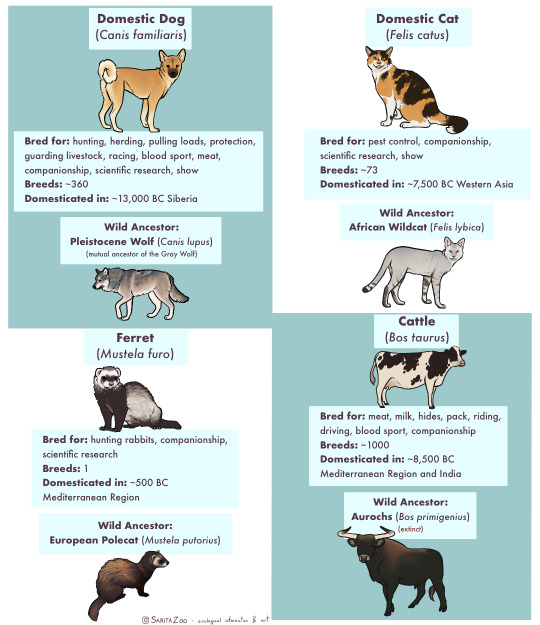


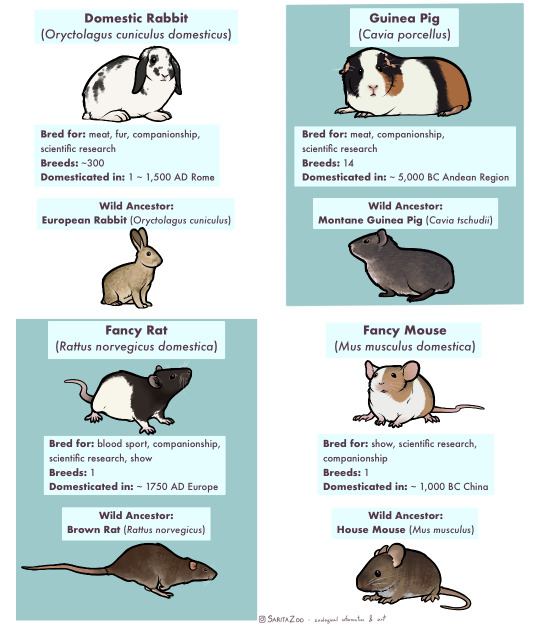
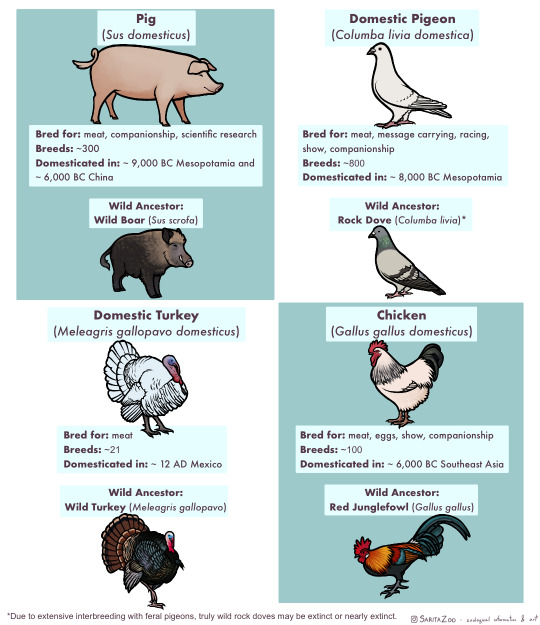
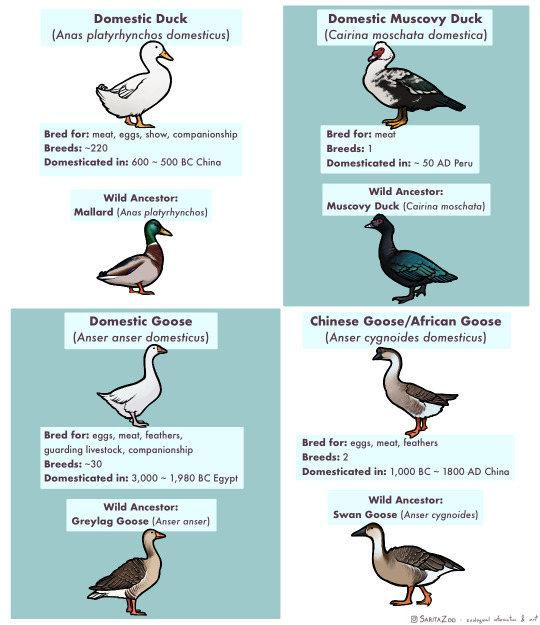
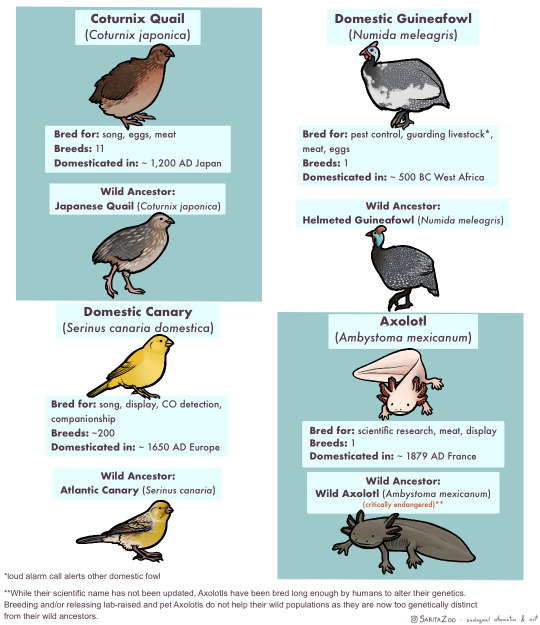
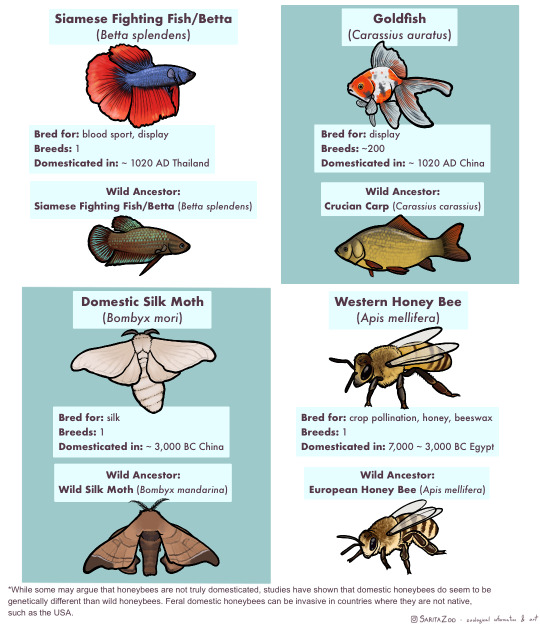

Phew. This one took, uh… a bit longer than expected due to other projects both irl and art-wise, but it’s finally here. The long-awaited domestic animal infographic! Unfortunately, I didn’t have enough space to cover every single domestic animal (I’m so sorry, reindeer and koi, my beloveds) but I tried to include as many of the “major ones” as possible.
I made this chart in response to a lot of the misunderstandings I hear concerning domestic animals, so I hope it’s helpful!
Further information I didn’t have any room to add or expand on:
🐈 “Breed” and “species” are not synonyms! Breeds are specific to domesticated animals. A Bengal Tiger is a species of tiger. A Siamese is a breed of domestic cat.
🐀 Different colors are also not what makes a breed. A breed is determined by having genetics that are unique to that breed. So a “bluenose pitbull” is not a different breed from a “rednose pitbull”, but an American Pitbull Terrier is a different breed from an American Bully! Animals that have been domesticated for longer tend to have more seperate breeds as these differing genetics have had time to develop.
🐕 It takes hundreds of generations for an animal to become domesticated. While the “domesticated fox experiment” had interesting results, there were not enough generations involved for the foxes to become truly domesticated and their differences from wild foxes were more due to epigenetics (heritable traits that do not change the DNA sequence but rather activate or deactivate parts of it; owed to the specific circumstances of its parents’ behavior and environment.)
🐎 Wild animals that are raised in human care are not domesticated, but they can be considered “tamed.” This means that they still have all their wild instincts, but are less inclined to attack or be frightened of humans. A wild animal that lives in the wild but near human settlements and is less afraid of humans is considered “habituated.” Tamed and habituated animals are not any less dangerous than wild animals, and should still be treated with the same respect. Foxes, otters, raccoons, servals, caracals, bush babies, opossums, owls, monkeys, alligators, and other wild animals can be tamed or habituated, but they have not undergone hundreds of generations of domestication, so they are not domesticated animals.
🐄 Also, as seen above, these animals have all been domesticated for a reason, be it food, transport, pest control, or otherwise, at a time when less practical options existed. There is no benefit to domesticating other species in the modern day, so if you’ve got a hankering for keeping a wild animal as a pet, instead try to find the domestic equivalent of that wild animal! There are several dog breeds that look and behave like wolves or foxes, pigeons and chickens can make great pet birds and have hundreds of colorful fancy breeds, rats can be just as intelligent and social as a small monkey (and less expensive and dangerous to boot,) and ferrets are pretty darn close to minks and otters! There’s no need to keep a wolf in a house when our ancestors have already spent 20,000+ years to make them house-compatible.
🐖 This was stated in the infographic, but I feel like I must again reiterate that domestic animals do not belong in the wild, and often become invasive when feral. Their genetics have been specifically altered in such a way that they depend on humans for optimal health. We are their habitat. This is why you only really see feral pigeons in cities, and feral cats around settlements. They are specifically adapted to live with humans, so they stay even when unwanted. However, this does not mean they should live in a way that doesn’t put their health and comfort as a top priority! If we are their world, it is our duty to make it as good as possible. Please research any pet you get before bringing them home!
34K notes
·
View notes
Text

Dromedary camel Camelus dromedarius
Observed by davidfbelmonte, CC BY-NC
85 notes
·
View notes
Text


Dromedaries (Camelus dromedarius) - (c) SaritaWolf - please do not repost
#Disclaimer: I went to Isr*el long before I knew what I know now. I would not make the trip again.#Mammalia#artiodactyla#Camelidae#Camelus#domesticated
0 notes
Text
Microbiology Research, Vol. 14, Pages 1687-1701: Evaluation of Predicted #siRNA as an Antiviral against MERS-CoV Targeting the Membrane Gene in the Vero Cell Line
The Middle East respiratory syndrome coronavirus (MERS-CoV) was first isolated from a patient with acute pneumonia and renal failure in Saudi Arabia in 2012. By July 2023, MERS-CoV had resulted in 2605 human cases worldwide, causing a fatality rate of 36%, with 90.2% of cases being located in the Arabian Peninsula. The dromedary camel (Camelus dromedarius) is presumed to be an intermediate host for viral transmission to humans. So far, no prophylactic vaccines or effective antiviral treatments have been approved for MERS-CoV. #RNA silencing is a novel approach for treating several diseases. A web-based bioinformatics tool (i-Score Designer) with integrative computational methods was used to predict and evaluate the designed #siRNAs. This approach enabled the targeting of a highly conserved region of the MERS-CoV membrane (M) gene to inhibit virus replication. #siRNA-M1, -M2, and -M3 were selected as the best of 559 designed #siRNA candidates for an in vitro validation based on 2nd generation algorithm scoring, thermodynamic properties, off-target filtration, position-specific nucleotide preferences, and a free immune-stimulatory motifs. #siRNAs were evaluated in Vero cells for their cytotoxicity and antiviral efficacy in vitro. Our results showed that the predicted #siRNAs had no apparent cytotoxicity observed in Vero cells. The obtained results from the plaque reduction assay and RT-qPCR indicated that #siRNA-M3 was the best candidate to inhibit MERS-CoV replication with a defined concentration of 400 picoMolar (pM). The computational methods used, and the in vitro evaluation, may provide an insight for a new antiviral strategy against MERS-CoV, a further in vivo study will nevertheless be required. https://www.mdpi.com/2036-7481/14/4/116?utm_source=dlvr.it&utm_medium=tumblr
0 notes
Text
Molecular and hematological investigation of Trypanosoma evansi infection in Iranian one-humped camels (Camelus dromedarius)
Pubmed: http://dlvr.it/Ss79cR
0 notes
Photo

Camel ~ Dromedary ~ Arabian Camel ~ Camelus dromedarius ~ Dromadaire ~ Chameau d'Arabie ~ Mount St. Catherine ~ Sinai Desert, Egypt #Camel #Dromedary #Arabiancamel #Camelus #Camelusdromedarius #Dromadaire #Chameau #Chameaud'Arabie #MountSt.Catherine #Sinai #Sinaï #SinaiDesert #Egypt #wildlifephotography #wildanimals #Macros #Macrophotography #Animalportrait #FaunaEgypt #Fauna ~ https://www.flickr.com/photos/rachidh/albums (at Sinai Egypt) https://www.instagram.com/p/CjLbPWPKh6K/?igshid=NGJjMDIxMWI=
#camel#dromedary#arabiancamel#camelus#camelusdromedarius#dromadaire#chameau#chameaud#mountst#sinai#sinaï#sinaidesert#egypt#wildlifephotography#wildanimals#macros#macrophotography#animalportrait#faunaegypt#fauna
0 notes
Photo

Dromedary camel (Camelus dromedarius)
Photo by John Dixon
#domestic#feral animal#dromedary camel#arabian camel#camel#camelus dromedarius#camelus#camelini#camelinae#camelidae#cameloidea#tylopoda#artiodactyla#ferus#scrotifera#laurasiatheria#boreoeutheria#eutheria#mammalia#tetrapoda#vertebrata#chordata
40 notes
·
View notes
Text
Cryptoproctus ferox. Fossa.
Galidia elegans. Ring-tailed vontsira.
Camelus dromedarius. Dromedary.
Procavia capensis. Rock hyrax.
Hydrochoerus hydrochaeris. Capybara.







6 notes
·
View notes